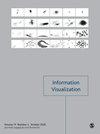支持可视化因果推理的反事实可视化实证研究
IF 1.8
4区 计算机科学
Q3 COMPUTER SCIENCE, SOFTWARE ENGINEERING
引用次数: 0
摘要
反事实--表达在不同情况下可能发生的真实情况--已被广泛应用于统计和机器学习领域,以帮助理解因果关系。最近,反事实开始作为一种技术应用于可视化研究中。然而,反事实在多大程度上有助于可视化数据交流,目前仍不清楚。在本文中,我们主要侧重于评估用户在使用反事实可视化时对数据理解的质量。我们将因果推理和可视化数据交流的理论联系起来,提出了一个初步的因果关系理解模型。利用这一模型,我们开展了一项实证研究,探索反事实如何在静态可视化中提高用户对数据的理解。研究结果表明,反事实可视化对参与者解释数据集中的因果关系有积极影响。这些结果促使我们讨论如何更有效地将反事实纳入数据可视化。本文章由计算机程序翻译,如有差异,请以英文原文为准。
An empirical study of counterfactual visualization to support visual causal inference
Counterfactuals – expressing what might have been true under different circumstances – have been widely applied in statistics and machine learning to help understand causal relationships. More recently, counterfactuals have begun to emerge as a technique being applied within visualization research. However, it remains unclear to what extent counterfactuals can aid with visual data communication. In this paper, we primarily focus on assessing the quality of users’ understanding of data when provided with counterfactual visualizations. We propose a preliminary model of causality comprehension by connecting theories from causal inference and visual data communication. Leveraging this model, we conducted an empirical study to explore how counterfactuals can improve users’ understanding of data in static visualizations. Our results indicate that visualizing counterfactuals had a positive impact on participants’ interpretations of causal relations within datasets. These results motivate a discussion of how to more effectively incorporate counterfactuals into data visualizations.
求助全文
通过发布文献求助,成功后即可免费获取论文全文。
去求助
来源期刊

Information Visualization
COMPUTER SCIENCE, SOFTWARE ENGINEERING-
CiteScore
5.40
自引率
0.00%
发文量
16
审稿时长
>12 weeks
期刊介绍:
Information Visualization is essential reading for researchers and practitioners of information visualization and is of interest to computer scientists and data analysts working on related specialisms. This journal is an international, peer-reviewed journal publishing articles on fundamental research and applications of information visualization. The journal acts as a dedicated forum for the theories, methodologies, techniques and evaluations of information visualization and its applications.
The journal is a core vehicle for developing a generic research agenda for the field by identifying and developing the unique and significant aspects of information visualization. Emphasis is placed on interdisciplinary material and on the close connection between theory and practice.
This journal is a member of the Committee on Publication Ethics (COPE).
 求助内容:
求助内容: 应助结果提醒方式:
应助结果提醒方式:


